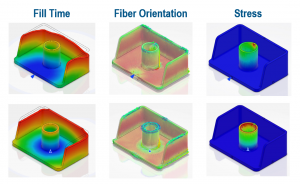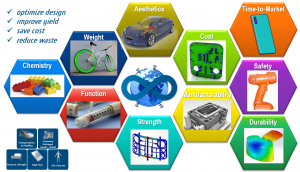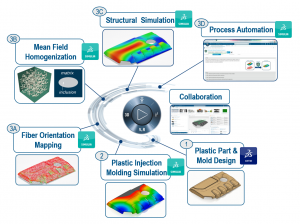Plastic materials are used everywhere in our daily lives for their many good qualities: light weight, low cost, manufacturing versatility, durability, corrosion resistance, and aesthetics. Take automobiles as an example, the usage of engineered plastics has been trending up with over 50% of the car interior now made of plastics. It is an inherited requirement of modern car design to switch from metals to plastics for higher fuel efficiency and less carbon footprint. On the other hand, how to reduce plastic waste and pollution has become a pressing global challenge, which requires simulation-driven smart designs.
Injection molding is perhaps the most common method for plastic manufacturing. To increase the structural strength, stiffness, and durability, chopped fiberglass or carbon fibers are often added to the resin as stiffeners when plastic parts are injection molded. The mechanical properties of fiber-reinforced plastics (FRPs) often exhibit strong anisotropy and temperature-dependency. These macroscopic thermomechanical properties largely depend on how fibers are oriented microscopically as the plastic flow gradually fills up the mold cavity, cools down below the melting temperature, and solidifies to take the molded shape. It is important to be able to predict the macro- and microscopic material behaviors and overall structural response of FRPs before parts are actually injection molded.

Mean-field homogenization (MFH)-based multiscale modeling has been proven an effective and computationally efficient method for characterizing the mechanical behaviors of FRPs. By taking into account individual constituents’ material properties as well as the orientations, shapes, and volume fractions of the fibers, complex nonlinear material behaviors and structural responses under thermomechanical loads can be accurately and quickly predicted. Quite often the fiber volume (or mass) fraction and aspect ratio are known inputs, and the material properties of the fiber and matrix can be obtained either directly from the material vendor or from the laboratory coupon testing. The fiber orientation, on the other hand, has to be measured experimentally after a prototype is actually manufactured. Therefore, it is almost impossible to optimize the material and structural performance of FRPs using this approach, not to mention the expensive costs associated with physical testing.
As a relatively cheaper alternative to physical testing, injection molding simulation can provide accurate predictions of the fiber orientation and temperature distributions used for MFH. Using injection molding simulations, plastic designers can assess the manufacturability and warpage of the parts, study the effects of the injection gates and runner system, and identify potential defects such as weld lines, air traps, and short shots.

Today, FRPs are often modeled as anisotropic materials with linear elastic properties or even oversimplified as homogeneous and isotropic. Such a cruel approximation can lead to significant discrepancies between the simulation results and experimental measurements, compromising the fidelity and accuracy of structural simulations. Combining injection molding simulation and MFH-based multiscale modeling, structural analysis engineers can accurately characterize the complex nonlinear material behaviors of the fiber and matrix, including plasticity, viscoelasticity, damage, and temperature-dependency, to assess the potential risks of structural fatigue and failure.
This all sounds great except that there lacks an integrated end-to-end solution as of today. In order to complete this process, multiple design and simulation tools from different vendors are often required. Data transfer across these different tools sometimes relies on translators, scripting, and simulation services. This is a one-way process and very difficult to use the insights from the structural analysis to guide the design. Needless to say, such a process is very expensive in terms of development time and monetary costs.

To solve this industry challenge, we have recently developed a 3DEXPERIENCE-based workflow for modeling FRPs with MFH-based multiscale material models. This end-to-end workflow includes part and mold design, plastic injection molding simulation, and structural simulation, integrated through simulation process and automation. The plastic injection simulation results including fiber orientation distributions can be used in the subsequent structural simulation for accurate characterization of micro- and macroscopic material behaviors. Through simulation process and automation, structural analysis engineers can quickly verify product requirements, explore “What-If” scenarios, and propose changes in design, with versioning and automatic traceability to maintain the digital continuity. Design of experiments and parametric optimization also can be used to study, for example, the effects of injection gate locations on the structural warpage, stiffness, and strength to achieve an optimal design. Customizable simulation templates can help deploy simulation processes to develop different products. We also published two Best-Practice documents to help structural analysis engineers and simulation process method developer on utilizing and developing this workflow, respectively.
This 3DEXPERIENCE-based workflow provides a one-stop-shop, end-to-end, integrated solution. We believe it can improve product quality, eliminate defected designs, reduce development time and costs, and accelerate innovation. We look forward to working with designers, simulation analysts, and manufacturers to help transform their business processes and together build a more sustainable and eco-friendly world.
SIMULIA offers an advanced simulation product portfolio, including Abaqus, Isight, fe-safe, Tosca, Simpoe-Mold, SIMPACK, CST Studio Suite, XFlow, PowerFLOW and more. The SIMULIA Learning Community is the place to find the latest resources for SIMULIA software and to collaborate with other users. The key that unlocks the door of innovative thinking and knowledge building, the SIMULIA Learning Community provides you with the tools you need to expand your knowledge, whenever and wherever.

